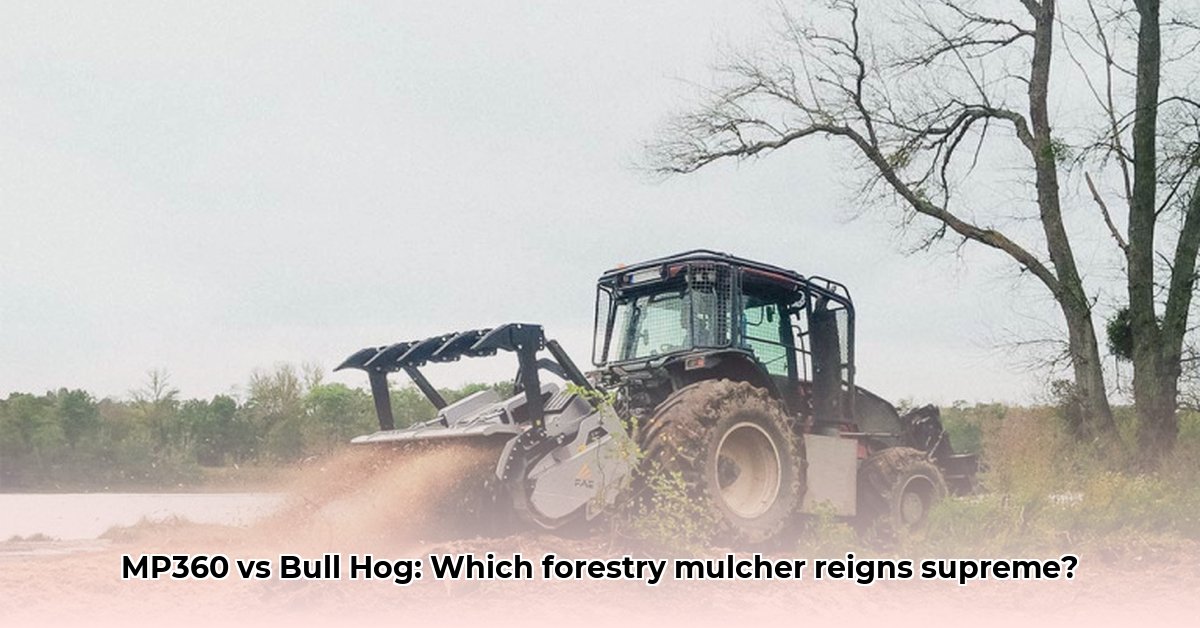
Choosing the right tractor forestry mulcher is a significant investment. This comparative review focuses on two leading models: the Baumalight MP360 and the Fecon Bull Hog. We'll analyze their performance, maintenance needs, and suitability for various applications to help you make an informed decision. For added power, consider a forestry winch.
Cutting Performance and Mulch Quality
Both the MP360 and the Bull Hog effectively mulch brush and small trees, but their cutting mechanisms differ significantly, impacting mulch quality and application suitability. The MP360 employs high-speed, carbide-tipped teeth, producing a finer mulch ideal for smaller projects and areas requiring a more refined finish. Think of it as a precision instrument for intricate work. The Bull Hog, conversely, uses a robust cutting system designed for consistent mulch size even in challenging conditions—a workhorse for large-scale land clearing projects where raw power is prioritized. Direct speed comparisons are difficult without controlled testing; performance varies significantly based on factors such as terrain, vegetation density, and operator skill. What size of vegetation are you primarily working with? This will largely dictate which machine is best for you.
Durability and Construction
Both mulchers are built for durability, but their designs reflect different approaches to longevity and resilience. The MP360 features durable, replaceable tooth holders and a powder-coated finish for rust resistance, suggesting ease of part replacement and a focus on extended lifespan. The Fecon Bull Hog, known for its heavy-duty construction, incorporates reinforced components like the PTO shaft and gearbox, implying superior resilience for tackling tough jobs and demanding environments. However, detailed information on specific materials and projected lifespan isn't readily available, necessitating further research. Independent testing and long-term user feedback would significantly benefit comparison, providing a clearer picture of long-term performance.
Tractor Power Requirements
A crucial difference lies in power needs. The MP360 is compatible with smaller tractors, making it a budget-friendly option for smaller properties or less demanding tasks. Its compact design and lower horsepower requirement translate to better fuel efficiency for smaller-scale operations. The Bull Hog, however, requires substantially more power (45-110 HP), necessitating a larger, more powerful tractor. This makes it best suited for extensive land clearing and heavy-duty mulching operations. Matching tractor power to the mulcher's requirements is paramount to prevent equipment damage and ensure optimal performance. What is the horsepower of your tractor? This question is critical in determining compatibility.
Maintenance and Repair Considerations
The MP360 emphasizes easy maintenance. The availability of readily accessible replacement parts and instructional videos minimizes downtime. This suggests that repairs are simpler for those without extensive mechanical experience and therefore potentially reduces labor costs. While the Bull Hog’s maintenance information isn't as readily accessible, its modular design—featuring replaceable shear bars—suggests a similar repairability. Direct comparisons of maintenance costs, encompassing both parts and labor, are crucial for a complete cost-benefit analysis. Contacting local dealers for service pricing is recommended for a clearer comparison.
Safety Features and Operator Protection
The MP360 includes a chain guard to contain flying debris, a crucial safety feature that minimizes the risk of operator injury. While specific safety features for the Bull Hog are less extensively publicized, its power and intended use suggest incorporation of comprehensive safety mechanisms. Independent verification through safety certifications and user testimonials would provide a more detailed comparison of both machines' safety features. Prioritizing safety is paramount when operating heavy machinery.
Comparative Summary Table
| Feature | Baumalight MP360 | Fecon Bull Hog |
|---|---|---|
| Ideal Tractor HP | Lower HP Tractors | 45-110 HP |
| Cutting Style | Fine, high-speed chipping | Consistent, robust cutting |
| Maintenance | User-friendly, readily available parts | Modular design, further information needed |
| Best Suited For | Smaller projects, finer mulch | Large-scale land clearing |
| Typical Cost | Generally more affordable | Generally more expensive |
Choosing Your Mulcher: A Decision Framework
- Budget: The MP360 generally offers a lower initial investment.
- Project Scope: The Bull Hog excels in large-scale land clearing.
- Tractor Compatibility: Ensure sufficient tractor horsepower.
- Maintenance Costs: Consider long-term maintenance and repair expenses.
- Operator Skill: The MP360's user-friendly maintenance might benefit less experienced operators.
Always consult with equipment dealers, request detailed specifications, and ideally arrange demonstrations before purchasing. Real-world testing in your specific conditions offers unmatched insight into a mulcher's suitability for your requirements.
Fuel Efficiency Considerations
Understanding fuel efficiency is crucial when comparing PTO brush mulchers. Direct comparisons require standardized testing, which is often unavailable. However, several factors influence fuel consumption:
- Engine Size and Type: Larger engines generally consume more fuel but may offer greater efficiency in heavy conditions.
- Rotor Design: Efficient rotor design can minimize fuel usage per unit of work.
- Cutting Width: A wider cutting width can increase efficiency per pass, but may demand more power.
- Operational Practices: Avoiding overloading significantly impacts fuel economy.
While direct fuel consumption comparisons are challenging without standardized testing, observing these factors can inform your selection process. A less fuel-efficient machine may still offer long-term cost savings due to superior durability and fewer repairs. Remember that fuel efficiency is just one aspect of the overall cost-effectiveness equation.